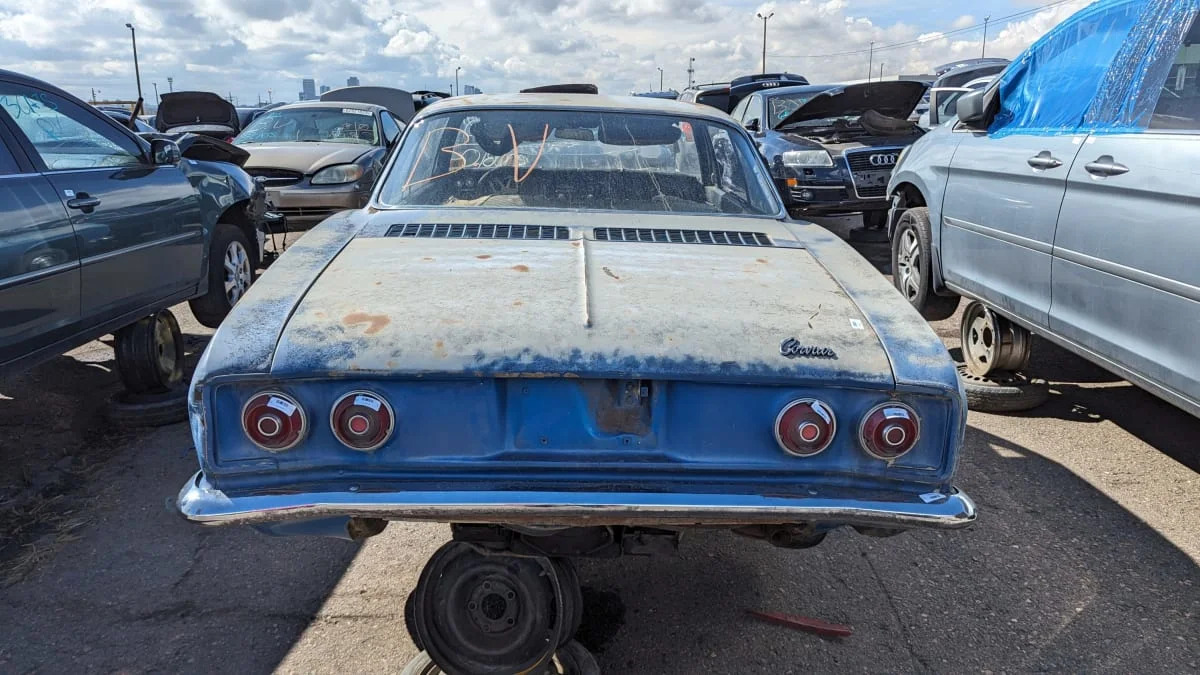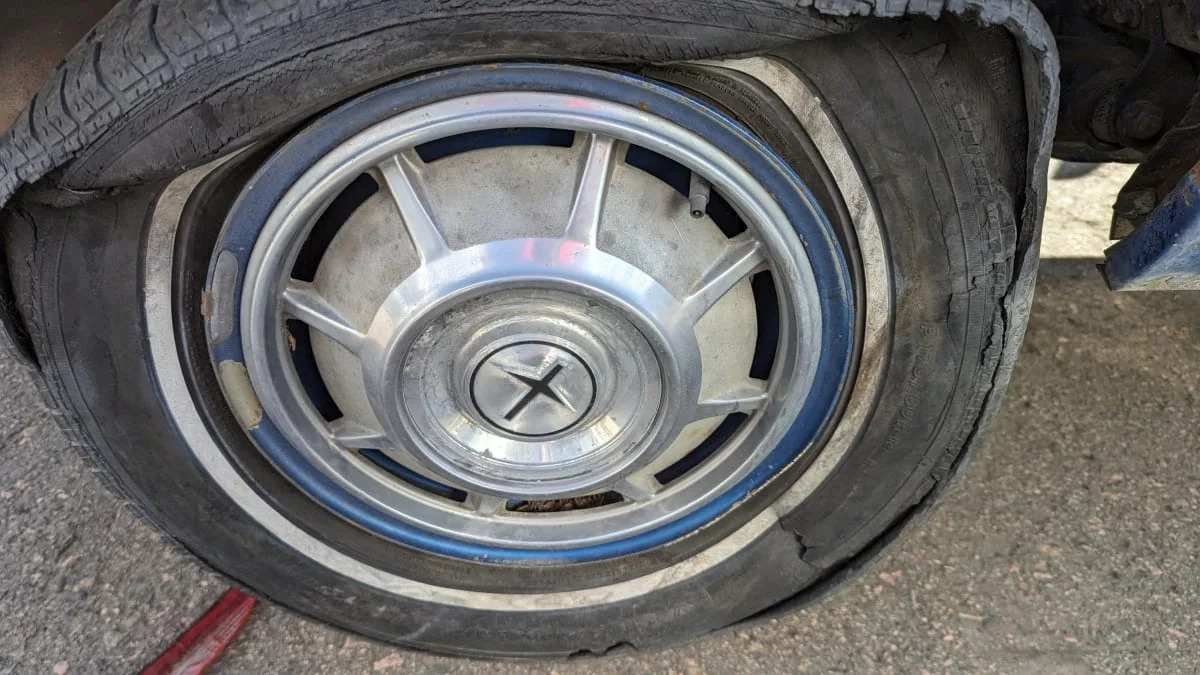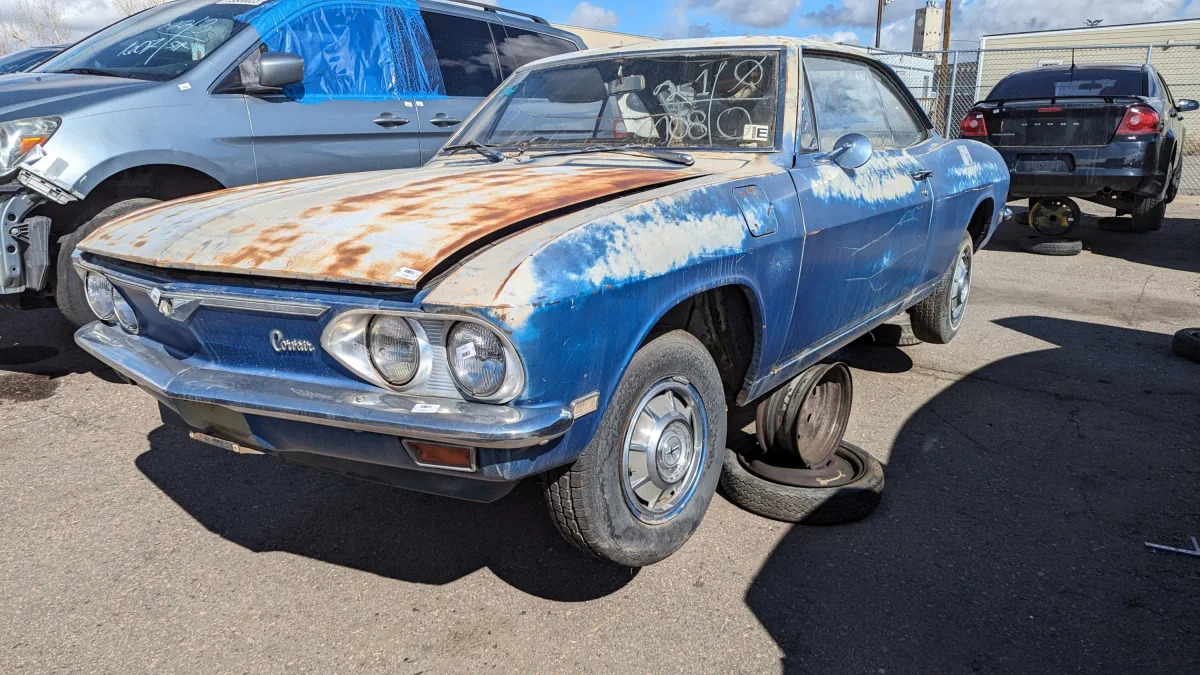Quick, what's the most controversial American car ever built? Was it the Edsel? The Pontiac Fiero? The Chrysler Airflow? That wasn't a serious question, because all of us know the answer already: the Chevrolet Corvair. Today's Junkyard Gem was built during the last gasps of Corvair production and now resides in a self-service car graveyard in Denver, Colorado.

Pick Your Part just shut down its funky, muddy old Denver operation on Federal Boulevard and moved it to a new location closer to the I-70/I-25 interchange. The cars sit on pavement instead of dirt, there's a nice view of downtown Denver, a taco truck sells lunches in the parking lot, and all the inventory was fresh for the April 1 grand opening.

I was one of the first customers to show up that morning, and so the Corvair still had all its badges when I found it.

More than 2 million Corvairs were built for the 1960 through 1969 model years, and plenty of them still sit in driveways, garages and yards awaiting repairs that never come. That means it's not too difficult to find examples of GM's radical rear-engined compact in junkyards to this day.

Since I started writing about discarded gems and treasures of automotive history in 2007, I've documented more than a dozen Corvairs in places like this, including a 1960 700 sedan, a 1962 700 wagon, another 1962 700 wagon, a 1962 Monza Club Coupe, a 1962 Rampside pickup, a 1963 Monza Club Coupe, another 1963 coupe, yet another 1963 coupe, still one more 1963 coupe, a 1964 convertible, a 1964 Monza sedan, a 1965 Monza coupe, a 1968 Monza coupe and a few dozen Corvairs sitting in a field near Pikes Peak.

The history of the Corvair is too complex for me to cover adequately here, so I suggest that you go read every word of automotive historian Aaron Severson's obsessively researched article on the subject before we go on.

The short version goes like this: Increasing numbers of American car shoppers were choosing small imported cars during the second half of the 1950s, with Volkswagen Beetles and Renault Dauphines moving out of showrooms in sufficient quantities to make Detroit at least slightly nervous. The American Motors Corporation cashed in on the trend by building compact Ramblers, which sold very well. Chrysler, Ford and GM each began developing compact cars that would debut as 1960 models.

Chrysler and Ford introduced some engineering and styling innovations with the Valiant and Falcon, but those cars were still reasonably traditional machines with water-cooled engines mounted up front and driving the rear wheels. General Motors, on the other hand, chose to go radical with its new Chevrolet compact.

To save weight and allow the use of a flat floor in the passenger compartment, the Corvair received an air-cooled boxer-six engine in the rear of the car. Combining the transmission and differential assemblies into a single transaxle unit and eliminating the liquid cooling system resulted in a nimble and efficient vehicle, with the first Corvairs scaling in at around 2,300 pounds.

With bench seats and a flat floor, six occupants would fit inside (Americans were both smaller and more tolerant of squeezing together in cars back then). There are some obvious drawbacks to the air-cooled/rear-engine design, of course; it's difficult to heat an air-cooled car in cold weather, for one thing. What proved to be more significant for Corvair sales was the different handling you get with a rear-heavy car equipped with a swingaxle suspension versus the "traditional" front-engined cars most Americans had been driving since the days of the Ford Model T.

Comedian Ernie Kovacs died in a widely publicized Corvair crash in 1962, and stories of Corvairs wiping out in oversteering, axle-jacking crashes became commonplace (many Corvair owners disregarded Chevrolet's recommendation of keeping front Corvair tire pressure at 15 psi, which didn't help matters). Corvair sales were strongest in 1961 and 1962, declined steadily from 1963 through 1965, then nosedived in 1966. Ralph Nader and his "Unsafe at Any Speed" book get most of the blame for the Corvair's demise from enthusiasts today, but that book wasn't published until late 1965 and didn't get much attention until fairly deep into the following year.

Chevrolet gave the Corvair a true independent rear suspension for 1965, but few paid much attention by that point. Sober hindsight shows that the Corvair wasn't significantly more dangerous than other compact cars of its era (in fact, just about all of them were deathtraps by modern standards), but car shoppers stayed away. Just 15,399 Corvairs were built as 1968 models, versus 377,371 for the 1961 model year.

The harshest competition for the Corvair came from within the Chevrolet Division itself, in the form of the Chevy II/Nova. Introduced as a 1962 model, that car looked and drove like a smaller version of the huge-selling big Chevys, while being just slightly bigger (and cheaper) than its air-cooled showroom neighbor. Starting with the 1963 model year, Chevy II sales beat Corvair sales and never looked back. As if the Corvair needed more trouble, for 1964 Ford introduced a sporty Falcon-based car that competed directly against the Corvair Monza coupe.

This car's interior is very rough from decades of outdoor storage. I found 1995 registration documents inside and there's a 1997 Colorado emissions-testing sticker on the windshield, so it's a safe bet that it hadn't driven under its own power for at least a quarter-century.

Passengers were encouraged to light up inside.

This car is a base 500 Sport Coupe (by 1968, only Corvair hardtop coupes and convertibles were available, in 500 and Monza trim levels), and it has the 95-horsepower engine.

1968 was the first year for the Corvair with the "Air Injector Reactor" system, otherwise known as the "smog pump." Most owners removed and discarded their AIR hardware, but this car still has all its original engine components.

Unusually, it was purchased with the optional two-speed Powerglide automatic transmission instead of the base three-on-the-floor or optional four-on-the-floor manual. This car would have been quite slow, even by 1968 standards, with the base engine and two-speed slushbox. The MSRP for this car was $2,243 ($20,412 in 2024 dollars) with three-speed manual, with the Powerglide adding $153 ($1,392 after inflation).

The body isn't rusty, and it's a rare late-production Powerglide car, but project Corvairs just aren't worth enough to spare all of them from a junkyardy fate. The good news is that Corvair parts, both used and reproduction, are still relatively easy to obtain. If you're looking for a 1960s Detroit project car that looks cool and is fun to drive, the Corvair is a wise choice.
Clings to the road like it had claws!










Sign in to post
Please sign in to leave a comment.
Continue